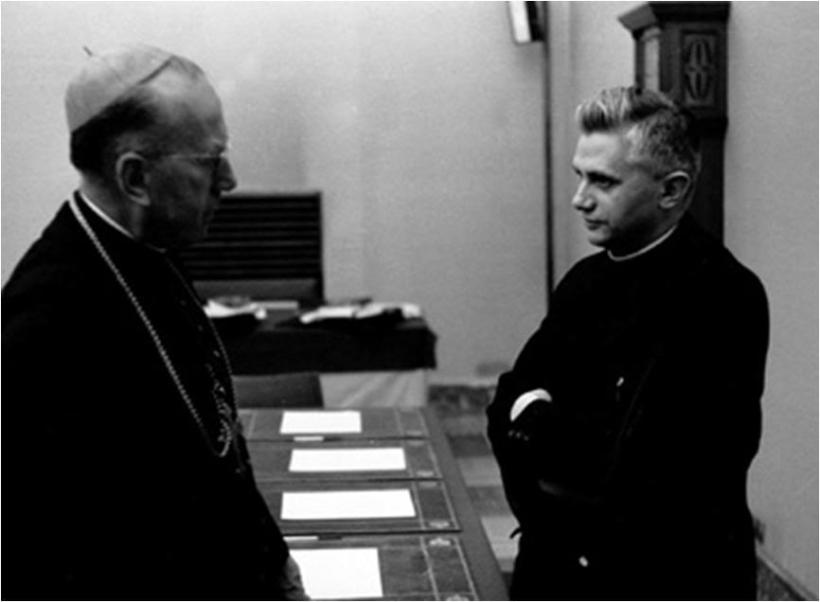
Our then-Archbishop, Theodore Card. McCarrick, participated in the April 2005 conclave that elected Joseph Ratzinger pope.
I remember how elated I was. Ratzinger the pope! I asked the older priests I lived with at the time if we could share a bottle of champagne that evening before dinner.
We didn’t. They were neither pleased by the election, nor amused by my request.
 We know now, of course, that McCarrick’s case was hanging fire in the Vatican in 2005. It had been hanging fire there for nearly a decade. The file already had multiple denunciations for sexual abuse in it.
We know now, of course, that McCarrick’s case was hanging fire in the Vatican in 2005. It had been hanging fire there for nearly a decade. The file already had multiple denunciations for sexual abuse in it.
We also now know that after Benedict took his seat in the Chair of Peter, McCarrick sent the new pope a gift of $200,000 cash.
A year later, in May 2006, McCarrick had reached the mandatory age of 75, and he retired as Archbishop of Washington. He began his new life as a full-time Cardinal diplomat, with no public declaration of any kind about his many ecclesiastical and civil crimes.
Fast forward fifteen years: An investigator working on the Vatican McCarrick report questions the now-retired Pope Benedict about McCarrick’s 2006 transition from Archbishop to globe-trotting Cardinal.
Benedict insists to the investigator that he had sent a “clear message of disapproval,” by secretly insisting on McC’s timely retirement as Archbishop, rather than allowing him two extra years in office.
Wait. “Clear message of disapproval?” Clear to whom?
—

Joseph Card. Ratzinger served as Archbishop of Munich, Germany, from 1977 to 1982. Then he became a Vatican official, then the pope.
Last week, a Munich law firm released a report they had prepared for the Archdiocese of Munich. The firm studied the archives of the archdiocese, from 1945 to 2019, in order to 1. identify criminal sex-abuser priests, and 2. consider how the archdiocese dealt with those priests’ cases.
The Munich report will benefit our Church tremendously in the long run. Like the French CIASE report, this report will help to facilitate a full encounter with the Catholic criminal-sex-abuse cover-up, one of the greater evils ever perpetuated by human beings.
The Munich report tackles the problem with a uniquely helpful approach: It assesses the decisions made by Church officials, measuring those decisions by the officials’ own rhetoric. That is: we as a Church stand with Christ on the side of the weak and suffering.

The Munich report is the total flip-side of our American “Reconciliation Programs” coin. Our own Reconciliation Program here in Richmond, like others done here in the US, involved an outside law firm studying the Church’s archives and identifying cases of sexual abuse. We paid out millions of dollars, just like the Archdiocese of Munich did.
But otherwise the two approaches to the problem are like photographic negatives of each other:
–In Munich, the lawyers gave the victim survivors’ the benefit of the doubt and doggedly cross-examined the Church officials. In our program, we did the opposite.
–In Munich they produced 1,900 pages of illuminating information for the general public. Here we produced 0 pages.
—

Friedrich Card. Wetter succeeded Ratzinger as Archbishop of Munich. He read the Munich law firm’s report over the course of the past few days. From the nursing home where Wetter lives, he made this statement:
I only became aware of the fatal consequences that abuse inflicts on children in 2010. I had not had a serious and thorough discussion up to that point. I didn’t deal with the perpetrators with the necessary severity. I have not lived up to my responsibility.
Indeed.
The Munich report covers the cases of dozens of criminal priests. The law firm, however, decided to single out one case for extra research. They came to regard this particular case as an emblematic instance of the long-term cover-up typically practiced by Church officials. The report calls it “Case 10.” It is the well-known case of Father Peter Hullermann.
I have referred to Father Hullermann here before. The German magazine Der Spiegel told his story back in 2010.
In 1979, as a young priest on a parish camp-out, Hullermann forced an 11-year-old boy to give him oral sex.
At that time, Hullermann belonged to the German diocese of Essen. The boy’s parents complained to the Church, and when diocesan officials confronted Hullermann, he admitted what he had done. He consulted with a psychotherapist in Essen, who referred him to another therapist, in Munich.
(No one, of course, told the police about the crime. Actually, I should say crimes, because Hullermann likely did the same thing on at least two other occasions between 1977 and 1979.)
Now, if you are a careful Vatican-news watcher, you know that our pope-emeritus made an official statement yesterday regarding a meeting in Munich that took place on January 15, 1980. He acknowledged yesterday that, ‘Yes, I actually did attend that particular meeting.’
Seems like a random thing to acknowledge, out of the blue. Certainly a 94-year-old retiree might have a hazy memory of events from half a lifetime ago. Maybe not such a big deal?

Actually, it’s a very big deal. Here’s the context:
At the meeting in question, the Munich “Ordinariate”–that is the governing Church officers–agreed to accept Hullermann as a transfer from Essen.
The bishop of Essen didn’t just neglect to inform the police; he also did not fully inform the officials in Munich about Hullermann–at least not in writing. He had a statement from the victim’s parents, as well as the Essen psychologist’s report, but he did not send those documents to Munich.
The Essen bishop did, however, indicate in a letter to Munich that Hullerman posed a “danger.” That January 1980 letter sits in the Archdiocese of Munich’s files, marked as cc’d to the Archbishop.
Hullerman went on to abuse many more children during his decades of priestly service. A civil criminal court convicted him in 1986, but gave him a suspended sentence. The Munich Archdiocese kept him in ministry until 2010. (Hence Cardinal Wetter’s apology above.)
Last fall the Munich law firm working on the report repeatedly wrote to pope-emeritus Benedict, confronting him with the facts of Hullerman’s 1980 transfer from Essen to Munich.
They also confronted him with facts about Hullerman’s move a year later, from one Munich parish to another, after talk of sexual acts with children at his first Munich assignment.
And they confronted Benedict with questions about 2010. In that year, the priest who had served as Ratzinger’s right-hand man in 1980 took the full blame for the cover-up, when the Hullermann story hit the press.
Benedict claims to have no memory whatsoever of Hullermann. He claims he never saw the letter from Essen indicating a danger (even though it’s marked as received by his then-office.)
Now, again: one might sympathize with a 94-year-old retiree having to answer questions about a meeting that took place during the Carter administration. But this was no cold case.
As I mentioned, Der Spiegel covered the whole thing in 2010, as did other German periodicals, and the New York Times as well. The question of Benedict’s role in Hullermann’s career sat squarely on the Catholic-news front burner.
We can safely say this: Joseph Ratzinger’s reputation in Germany rests on his involvement in the case of Father Peter Hullermann. And he knows it.
In a letter Benedict sent to the law firm in December, our pope-emeritus insisted: not only did he know nothing of Hullermann, he had not been present for the January 15, 1980 meeting at which Hullermann’s transfer to Munich was approved.
[NB. I have undertaken to translate pertinent sections of the Munich report into English. Not perfect, but serviceable. Click HERE to access the on-line files.]
But then Benedict faced a problem this month. The law firm has the minutes of the January 1980 meeting. Those minutes prove beyond any doubt both that 1. Benedict was present at the meeting and 2. he had personally spoken with the bishop of Essen about Hullermann, twice (at least).
In other words: Ratzinger, caught in a lie.
—
Back in 2019, Benedict published an essay about the sex-abuse crisis. He made a dishonest statement in that essay. He blamed the “Sexual Revolution of 1968” and its effect on children for the “extensive collapse of the next generation of priests.”
But..
1. This chronology is at least a decade off. In his essay, Benedict laments explicit sex-education in the 1970’s. But Hullermann and his contemporary priest-criminals were already adults by then.
2. The sexual revolution, for all its many faults, never led to the widespread acceptance of pedophilia. Some extreme libertines have argued for free sex between adults and minors, but Western society as a whole has always rejected this. Since the advent of Christianity, we have considered the sexual abuse of a child to be a damnable crime.
That is, all of us have thought that, except our bishops and popes.
—
The Munich report concludes that Ratzinger knew that Hullermann posed a danger, and did nothing about it. If this is true, Joseph Ratzinger owes a lot of people a personal apology, and whatever reparation he can muster.
Is the law firm wrong, and Benedict isn’t lying? He really knew nothing about one of his priests–a priest that all the other diocesan officials knew was a serial pederast?
That would actually probably be even worse. A shepherd that clueless actually became the freaking pope? Seriously?
The law firm takes no position on the question of whether or not the Vatican and the Munich chancery pressured the right-hand man from 1980 to take all the blame in 2010. There isn’t enough evidence to come to a conclusion about that.
But that lack of evidence has resulted from Benedict’s own recalcitrance. Here is our pope-emeritus’ repeated response to all of the law firm’s questions touching on anything that happened after the early days of 1982:
That question does not pertain my service as Archbishop of Munich, so it lies outside the scope of your inquiry.
 Our “transparent” Church.
Our “transparent” Church.
—
I remain a committed conservative Catholic priest. I love the Catechism with Ratzinger’s imprimatur more than just about anything in the world.
But I was wrong when I wanted to drink champagne on the evening of April 19, 2005. I thought it was a happy day. It wasn’t.
Reblogged this on .
Where can I find your blog? Thank you.
Popes and bishops lie. Popes and bishops claim they “didn’t know” that child sex abuse was a crime.
Why in God’s name does the Catholic laity put up with these evil leaders? Why don’t you rise up and throw out your bishops?
Ann White
Thank you Father White. Hard as it is, we need to know. I used to follow Father Luigi Villot. He was given a mandate by Padre Pio, followed up by a commission from Pope Pius Xll to spend his priestly life investigating the masonic infiltration of the Church. He did that and suffered greatly. He started and edited a magazine named Chiesa Viva.
Then again, Pope Benedict lied to us when he denied that he told Father Ingor Dollinger that “yes” there was more information in the Third Secret than he gave us. Next day he denied he said that. Father Dollinger has a sterling reputation. I had a hard time believing … but now I do believe.
Addendum to my comment: Benedict XVll is written up in Father Villa’s magazine. yumpa.com/fr/document/read/17511207/la-mitre-satanique-bxvi-fr is one place you can find it
The little known truth about the pseudo-traditionalist Josef Ratzinger can be seen at novusordowatch.org/benedict-xvi/
Much more little known and scandalous information is at that website as well.
“It is better for scandal to arise than for the truth to be kept hidden.” (St Pius X)